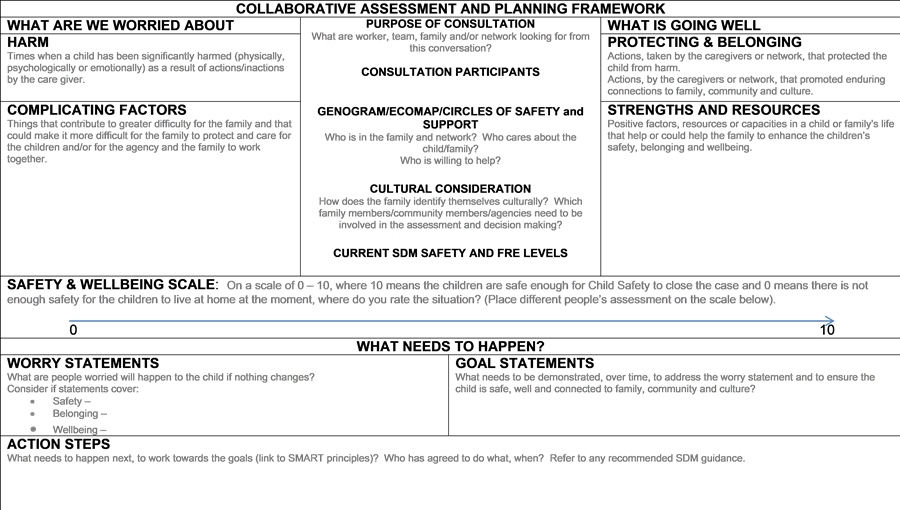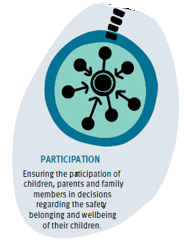Care arrangement decision making
Having children removed may be one of the hardest things any parent can experience, regardless of the trauma they have endured. When children enter care, parents may be aggressive, hostile, threatening and inconsolable, making it difficult to engage with them. Most of the time, these behaviours are in response to the traumatic experience they are currently going through.
Once they’ve had time to process what has happened, they will be able to work with you to help provide the best care arrangement a child can have while care is required. Be mindful not to use their behaviour on the day their child first enters the care system as a reason to withhold information. Remember that information equals power, and at this point in time, the parents are feeling powerless. Make efforts to restore their sense of power.
Collaborative assessment and planning framework tool
The Collaborative assessment and planning framework tool enables a rigorous and balanced assessment to be undertaken with parents. The process of case ‘mapping’ uses the collaborative assessment and planning framework to organise all the known information about a child and parents at any given time into four domains relevant to the goal of enhancing ongoing safety, belonging and wellbeing for the children.
Four domains of inquiry
The collaborative assessment and planning framework is organised around four main questions:
- What has happened/is happening within the family that worries us? (Harm and complicating factors.)
- What is going well within the family? (Protection and belonging, and strengths and resources.)
- Safety and wellbeing scale: On a scale of 0 to 10, how safe is it for the children in the care of the family at this point in time?
- What needs to happen for the children to be safe and well in the future? (Identifying future worries, collaborative goals and action steps to achieve these goals.)
As these four domains illustrate, the collaborative assessment and planning framework focuses on understanding what has happened and what is happening within a care arrangement in relation to the safety, belonging and wellbeing of the children, and then working together with a child’s network to plan for the future.
Including all four domains of inquiry ensures a balanced assessment focusing on the worries as well as on what is going well. It also ensures that the focus is on moving forward from the past and on building future safety and wellbeing for children.
Further reading
The Collaborative Assessment and Planning Framework provides a range of strengths-based questions you can use in your engagement with parents.

Information sharing
Providing information to the parents
In accordance with the Act, we provide written letters to parents advising them of any decision about a care arrangement, as some decisions are reviewable through the Queensland Civil and Administrative Tribunal (QCAT). The letter will outline the reasons for the decisions, which need to be consistent with conversations you’ve had with the parents, information already provided to them and the case plan goal, as applicable.
The letter is more than just compliance with our legislative requirements, as it helps prepare the parent for the decision or a transition and provides all the information to them regarding a decision about their children. This is an empowering process for the parent and demonstrates participation at its highest level when the content of the letter is already known to the parent as you have implemented strategies to include them in every step of the process.
Be sure to consider culturally appropriate communication with the parents and provide a culturally safe space to engage with them. Culturally safe practices include actions that recognise and respect the cultural identities of others and safely meet their needs, expectations and rights. See the Working with Aboriginal and Torres Strait Islander people part of this practice kit for more information on this topic.
Time sensitive
Remember parents have 28 days after the date of one of the abovementioned letters to apply to QCAT to have the decision reviewed. Provide the letter as soon as possible after the decision about the care arrangement has been made, to ensure there is time to take any actions required to help address the parents’ worries.
Ideally, the parent will have been involved in the decision-making process and will be fully aware of the content of the letter before receiving it. This reduces the likelihood of confrontation and increases the chance that they will understand the decision and working with you.
The majority of time parents can be provided with all information regarding their children’s care arrangements, including the carer’s name, address and telephone number. However, it is sometimes necessary to withhold all information (if sharing the information means the risk to the children and carer’s safety is high). In these instances, a rigorous and balanced assessment identifying the risk and protective factors in this situation is needed.
Practice prompt
When placing an Aboriginal and Torres Strait Islander child in care and/or supporting a care arrangement with non-Indigenous carers or Indigenous carers from a different community, how do you find out what child rearing practices are important for the family to continue with the child while in care?
Mechanisms you can use to help work through this with the family include:
- strengths cards (see Part 3 Working with children and young people for more information)
- storytelling
- The Three Houses Tool (completed with the parent about their worries and what their dreams are for the child’s care arrangement)
- parents and extended family members actively participating in the child’s daily activities such as schooling and doctors’ visits
- parents and extended family members working in partnership to co-parent the child and actively participate in the safety and support network.
Engagement strategies with Aboriginal and Torre Strait Islander families need to come from a place of authenticity and collaboration—true partnership.
When seeking information from family members, be aware of their hesitation to share information about their family and their culture with a non-Indigenous worker, due to past experiences with governments. Approach this topic sensitively and let the family know why you are asking for the information and what the information will be used for.
Example questions
You can use the following sorts of questions to help frame your culturally safe conversations with the family:
Not knowing—As a person from a different cultural background, there may be things about you, your family and/or your culture that I do not understand. When I encounter those things, would it be okay if I ask you about them?
Local wisdom—Have others from your family, culture or heritage had to face challenges like this before? What did they do? How did they survive? What wisdom of theirs would be good to use in our work?
Naming oppression—Do you think people from the same particular cultural or ethnic group have had to face these kinds of problems more than others? How do you make sense of this?
Parents sharing information with children
Parents are sometimes the most appropriate people to share important decisions with their children. An example of this includes when children are changing care arrangements or an application is before the courts for their long-term care.
Where it is assessed as appropriate, having the parent share decisions with children will contribute to their relationship. It is ideal for parents to be the main adults to share decisions with the children.
To ensure that when parents provide children with significant decisions it is a positive and thoughtful process, a lot of preparation with the parent may be required. Some decisions the parents will not like nor support (for example, removal from kinship carers) so encouragement and information sharing will need to take place with the parent prior to them advising the child.
Practice prompt
Consider what practice tools may assist the conversation with the parent and how parents could also use the practice tools to engage with their child.
The Immediate Story is a great tool to share decision making with children, and the parents can help tell the story to their child, owning the process. Make sure the information shared is age-appropriate and child-friendly.
Published on:
Last reviewed:
-
Date:
Maintenance
-
Date:
Maintenance
-
Date:
Maintenance
-
Date:
Maintenance
-
Date:
Maintenance
-
Date:
Terminology change - placement to care arrangement
-
Date:
Page created
-
Date:
Page created


